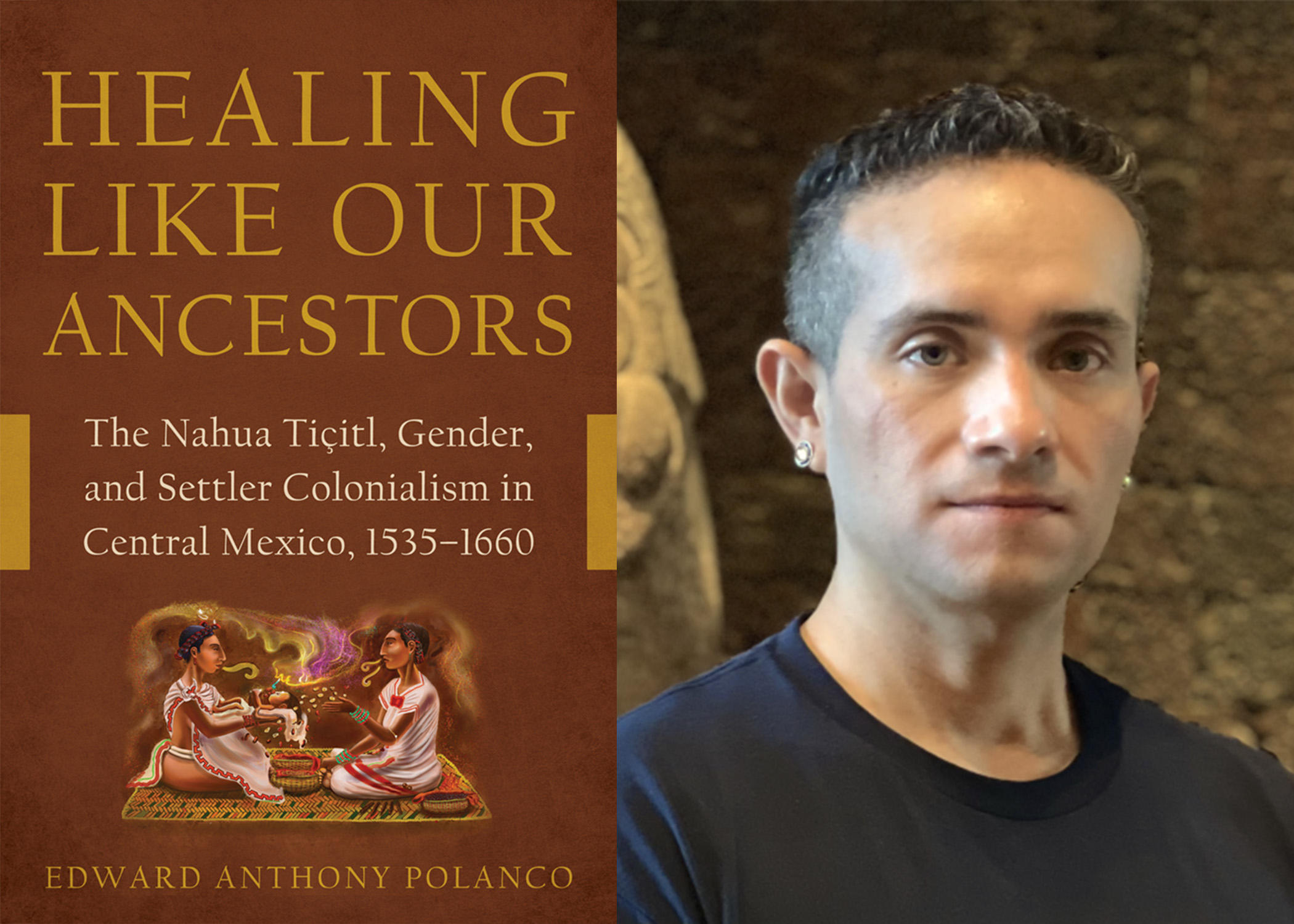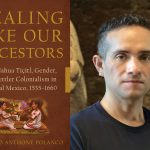August 29, 2024
Healing Like Our Ancestors: The Nahua Titiçih, Gender, and Settler Colonialism in Central Mexico, 1535-1660, by Edward Anthony Polanco, offers a provocative new perspective the examines sixteenth-and seventeenth-century Nahua healers in central Mexico and how their practices have been misconstrued and misunderstood in colonial records.
Early colonial Spanish settlers defined, assessed, and admonished Nahua titiçih (healing specialists) and tiçiyotl (healing knowledge) in the process of building a society in Mexico that mirrored Iberia. Nevertheless, Nahua survivance (intergenerational knowledge transfer) has allowed communities to heal like their ancestors through changes and adaptations. Polanco draws from diverse colonial primary sources, largely in Spanish and Nahuatl (the Nahua ancestral language), to explore how Spanish settlers framed titiçih, their knowledge, and their practices within a Western complex. Polanco argues for the usage of Indigenous terms when discussing Indigenous concepts and arms the reader with the Nahuatl words to discuss central Mexican Nahua healing. In particular, this book emphasizes the importance of women as titiçih and highlights their work as creators and keepers of knowledge. These vital Nahua perspectives of healing—and how they differed from the settler narrative—will guide community members as well as scholars and students of the history of science, Latin America, and Indigenous studies. Read an excerpt from the book’s introduction below.
“From the Peruvian Andes to the French court, the potato’s voyages”—thus reads the title of a sign explaining how the potato made its way to Spain. In July 2022, I had the privilege of visiting the Real Jardín Botánico (Royal Botanical Garden) in Madrid. I had read about the garden in books and was curious about its contents. When I asked a garden employee where I could see plants indigenous to the Americas, she informed me that the gardeners had dispersed them throughout the grounds and that the garden’s sections were not organized by geographic location. I immediately looked for corn (Zea mays) and tobacco (Nicotiana sp.), which I was surprised to find growing next to each other in the huerta, or orchard, section. There, like thousands of visitors every year, I was also able to see squash, beans, potatoes, sunflowers, tomatoes, and peppers. Though many of the plants in the orchard are native to Turtle Island (what is now called North America) and Abya Yala (what is now called Central and South America), there was no such descriptor or recognition. I then moved on to the medicinal section, which contained only two plants from Abya Yala, huevo de gallo (Salpichroa origanifolia) and epazote (Dysphania ambrosioides).
In the entire botanical garden, the only placard I found that explained an “American” plant was a sign for what Spaniards call the patata, or the papa in Quechua and Latin American Spanish (potato in English). Most of the text about the potato revolved around its European “discovery” in the Americas and the untapped knowledge about its nutritional attributes, unknown to Europeans until the eighteenth century. One short sentence explained that papas had been domesticated in the Chilean and Peruvian Andes eight thousand years ago. The placard made no mention of the Native cultures that had cultivated (and continue to cultivate) the root, nor did it explain the cultural significance of the papa in what is today known as South America.
This situation embodies the erasure of Native knowledge and culture that occurs with the extraction of native plants. The Real Jardín Botánico presents corn, tomatoes, beans, squash, and tobacco as plants with no Native history or culture. Though this is largely true for many of the plants in the garden irrespective of their origin, it is particularly troubling when the plants were extracted from other parts of world through colonial ventures. In the case of the papa, it appears as a once exotic plant that Europeans haphazardly dominated with their culinary and economic control. The botanical garden’s thousands of visitors could be learning about the vibrant, complex, and diverse knowledge and goods that Native people have willingly and unwillingly provided Spain and its once global empire. Visitors could also learn the importance of native plants in their Native contexts, their uses, and their indigenous names. For instance, corn is originally from Mesoamerica, and it is important to many Native communities throughout Turtle Island and Abya Yala for sustenance, healing, and as a relative. Tobacco, similarly, is a spiritual medicine, and the aromatic plant enjoys therapeutic uses as well.
Before Columbus arrived in the Western Hemisphere, Native peoples throughout Turtle Island and Abya Yala knew about corn and tobacco and grew it. Jesuit priest and settler Francisco Clavijero noted in the late eighteenth century that to Nahuas in Mexico tlaolli (corn kernels) were one of the most important food items, like wheat to Europe and rice to Asia. Nahuas had diverse types of corn that were nutritious and often eaten as “bread” (i.e., tortillas) made by women, and atolli (atole, a corn-based beverage), which had medicinal properties. Nahuas in the sixteenth century often gave cocoxqueh (sick people) atolli to nurse them back to health. Cintli (the entire corn plant) forms a core component of Indigenous foods from Mesoamerica, including tortillas, tamales, and atoles.
Moreover, many Native communities attributed special powers and reverence to tobacco. The Dominican friar Bartolomé de Las Casas reported in the sixteenth century that the Taíno people in what is now the Dominican Republic and Haiti smoked leaves resembling lettuce, which they dried and rolled into the shape of a musket (the musket was called a tabaco). The leaves functioned as a corporal sedative, and Taínos also used them to suppress hunger and fatigue. Gonzalo Fernández de Oviedo y Valdés further recorded sixteenth-century ceremonial uses of tabaco among the Taíno, who employed the leaves to gain unknown information. Las Casas reported that in what is now Mexico, the Tlaxcalteca used tobacco (piçiyetl in sixteenth-century Central Mexican Nahuatl and iatl in modern variants of Nahuatl) to tranquilize snakes and that it also boasted many medicinal properties, though he did not expand on them. By the 1570s, the physician Francisco Hernández had learned of a number of health benefits to be gained from smoking the dry leaves: tobacco was a great expectorant, cured asthma and difficulties breathing, was good for women having irregularities with their uterus, fortified the mind, caused drowsiness, and calmed pain. Fresh leaves were good for digestion and cured empacho (abdominal bloating and pain). Nahua specialists also used piçiyetl as an entheogen—a substance to release a nonhuman life force within. For example, healers used piçiyetl and other entheogens to communicate with nonhuman forces and to diagnose and prognosticate illnesses and injuries. Thus, it seems that tobacco might have been better suited to the Real Jardín Botánico’s medicinal section.
Effacing or obfuscating the names and knowledge of indigenous plants is part of the colonial game. Now operated by the Consejo Superior de Investigaciones Científicas, the Real Jardín Botánico could use its privilege and status to acknowledge the Indigenous names of native plants when making use of plants, technologies, and knowledge acquired from Indigenous peoples.
 The University of Arizona Press
The University of Arizona Press


